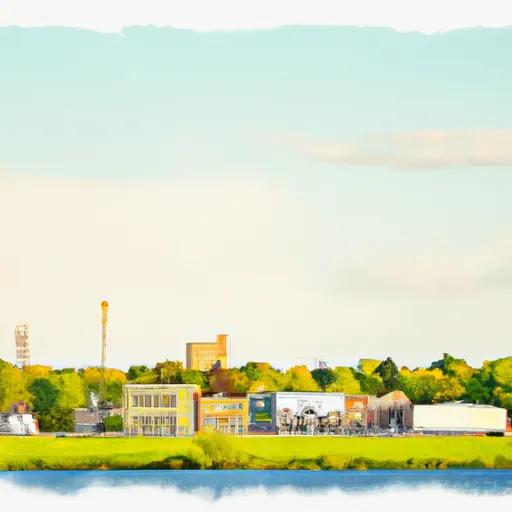-
 Snoflo Premium
Snoflo Premium
Get unlimited access to all our content
With no Ad interruptions! - Start Your Free Trial Login with existing account
Saint-James
Eden Index
Climate
6.5
•
Recreation
2.0
•
Community
0.9
•
Safeguard
3.5/10

Saint-James, Michigan is a quaint town nestled in the heart of the Midwest. The climate of this region is characterized by four distinct seasons, with warm summers and cold winters. Summers are mild, with temperatures ranging from 70°F to 80°F, perfect for outdoor activities like hiking and biking. Winters bring snowfall and temperatures often drop below freezing, creating opportunities for skiing, snowboarding, and ice fishing.
Hydrologically, Saint-James is blessed with numerous lakes and rivers, making it a paradise for water enthusiasts. The pristine waters offer various recreational activities such as boating, kayaking, and fishing, with abundant species like bass, trout, and walleye.
In terms of outdoor recreation, Saint-James boasts an extensive network of scenic trails for hiking and biking. Nature lovers can explore lush forests, picturesque parks, and observe diverse wildlife. Additionally, the area offers opportunities for camping and picnicking, allowing visitors to enjoy the natural beauty and tranquility.
Overall, Saint-James, Michigan provides an idyllic setting for individuals seeking an array of outdoor activities, from water sports to hiking, ensuring a memorable experience for nature enthusiasts and adventure seekers alike.
What is the Eden Index?
The Snoflo Eden Index serves as a comprehensive rating system for regions, evaluating their desirability through a holistic assessment of climate health, outdoor recreation opportunities, and natural disaster risk, acknowledging the profound impact of these factors on livability and well-being.
Climate Health Indicator (CHI): 6.5
Saint-James receives approximately
791mm of rain per year,
with humidity levels near 83%
and air temperatures averaging around
7°C.
Saint-James has a plant hardyness factor of
5, meaning
plants and agriculture in this region thrive during a short period during spring and early summer. Most
plants will die off during the colder winter months.
By considering the ideal temperature range, reliable water supplies, clean air, and stable seasonal rain or snowpacks, the Climate Health Indicator (CHI) underscores the significance of a healthy climate as the foundation for quality living.
A healthy climate is paramount for ensuring a high quality of life and livability in a region, fostering both physical well-being and environmental harmony. This can be characterized by ideal temperatures, reliable access to water supplies, clean air, and consistent seasonal rain or snowpacks.
Weather Forecast
Streamflow Conditions
Lake Michigan
Area Rivers
Lake Michigan
Snowpack Depths
Lake Michigan
Reservoir Storage Capacity
Lake Michigan
Groundwater Levels
Recreational Opportunity Index (ROI): 2.0
The Recreational Opportunity Index (ROI) recognizes the value of outdoor recreational options, such as parks, hiking trails, camping sites, and fishing spots, while acknowledging that climate plays a pivotal role in ensuring the comfort and consistency of these experiences.
Access to outdoor recreational opportunities, encompassing activities such as parks, hiking, camping, and fishing, is crucial for overall well-being, and the climate plays a pivotal role in enabling and enhancing these experiences, ensuring that individuals can engage in nature-based activities comfortably and consistently.
Camping Areas
| Campground | Campsites | Reservations | Toilets | Showers | Elevation |
|---|---|---|---|---|---|
| Culhane Lake - State Forest | 22 | 635 ft | |||
| Blind Sucker 1 - State Forest | 13 | 634 ft | |||
| Blind Sucker 2 - State Forest | 32 | 635 ft | |||
| Pretty Lake - State Forest | 27 | 761 ft | |||
| Holland Lake - State Forest | 15 | 760 ft | |||
| Mouth of Two Hearted River - State Forest | 39 | 615 ft | |||
| Bodi Lake - State Forest | 20 | 650 ft | |||
| High Bridge - State Forest | 7 | 720 ft | |||
| Muskallonge Lake State Park | 170 | 644 ft | |||
| Lake Superior - State Forest | 18 | 627 ft |
Nearby Ski Areas
Catastrophe Safeguard Index (CSI):
The Catastrophe Safeguard Index (CSI) recognizes that natural disaster risk, encompassing floods, fires, hurricanes, and tornadoes, can drastically affect safety and the overall appeal of an area.
The level of natural disaster risk in a region significantly affects safety and the overall livability, with climate change amplifying these risks by potentially increasing the frequency and intensity of events like floods, fires, hurricanes, and tornadoes, thereby posing substantial challenges to community resilience and well-being.
Community Resilience Indicator (CRI): 0.9
The Community Resilience Indicator (CRI) recognizes that education, healthcare, and socioeconomics are crucial to the well-being of a region. The CRI acknowledges the profound impact of these elements on residents' overall quality of life. By evaluating educational resources, healthcare accessibility, and economic inclusivity, the index captures the essential aspects that contribute to a thriving community, fostering resident satisfaction, equity, and social cohesion.

